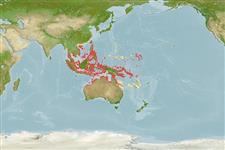Common names from other countries
>
Eupercaria/misc (Various families in series Eupercaria) >
Labridae (Wrasses) > Corinae
Etymology: Halichoeres: Greek, als, alis = salt + Greek, choiros = pig (Ref. 45335).
More on author: Bloch.
Environment: milieu / climate zone / depth range / distribution range
Ecologia
marinhas associadas(os) a recifes; intervalo de profundidade 0 - 10 m (Ref. 9710). Tropical; 19°N - 12°S
Western Central Pacific: Philippines to the Great Barrier Reef (Ref. 2334). Restricted to the Indo-Malayan region in the broad sense.
Tamanho / Peso / Idade
Maturity: Lm ? range ? - ? cm
Max length : 19.0 cm SL macho/indeterminado; (Ref. 9823)
Descrição suscinta
Chaves de identificação | Morfologia | Morfometria
Espinhos dorsais (total) : 9; Raios dorsais (total) : 10 - 11; Espinhos anais: 3; Raios anais : 10 - 11; Vértebras: 25. Usually bright green in algae habitat, but pale or with longitudinal dark bands on plain rubble (Ref. 48636). Head of male with intricate reticulate pattern of bands that varies from one individual to another; small blackish spot on anus. Juveniles and females with dark dots dorsally and posteriorly; these are lost in males. Anterior lateral line scales with 1-3 pores; 8-13 suborbital pores. Anterior dorsal and anal soft rays longer than posterior rays; male pelvic fins not reaching the anus.
Inhabits shallow protected coral reefs and nearby silty sand and rubble bottoms (Ref. 2334). Feeds mainly on hard-shelled prey, including mollusks, crustaceans and sea urchins (Ref. 9823).
Ciclo de vida ou comportamento de acasalamento
Maturities | Reprodução | Spawnings | Egg(s) | Fecundities | Larvas
Distinct pairing during breeding (Ref. 205).
Randall, J.E., G.R. Allen and R.C. Steene, 1990. Fishes of the Great Barrier Reef and Coral Sea. University of Hawaii Press, Honolulu, Hawaii. 506 p. (Ref. 2334)
Status na Lista Vermelha da UICN (Ref. 130435)
CITES (Ref. 128078)
Not Evaluated
Ameaça para os humanos
Harmless
Uso pelos humanos
Pescarias: pouco comercial; Aquário: Espécies comerciais
Ferramentas
Relatórios especiais
Baixar XML
Fontes da internet
Estimates based on models
Preferred temperature (Ref.
115969): 28 - 29.3, mean 28.8 (based on 1830 cells).
Índice de diversidade filogenética (Ref.
82804): PD
50 = 0.5000 [Uniqueness, from 0.5 = low to 2.0 = high].
Bayesian length-weight: a=0.00741 (0.00424 - 0.01297), b=3.03 (2.88 - 3.18), in cm Total Length, based on LWR estimates for this species & Genus-body shape (Ref.
93245).
Nível Trófico (Ref.
69278): 3.4 ±0.40 se; based on food items.
Resiliência (Ref.
120179): médio(a), tempo mínimo de duplicação da população 1,4 - 4,4 anos (Preliminary K or Fecundity.).
Fishing Vulnerability (Ref.
59153): Low vulnerability (13 of 100).
